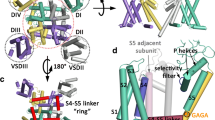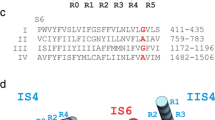Abstract
Low-voltage-activated CaV3 channels are distinguished among other voltage-activated calcium channels by the most negative voltage activation threshold. The voltage dependence of current activation is virtually identical in all three CaV3 channels while the current kinetics of the CaV3.3 current is one order slower than that of the CaV3.1 and CaV3.2 channels. We have analyzed the voltage dependence and kinetics of charge (Q) movement in human recombinant CaV3.3 and CaV3.1 channels. The voltage dependence of voltage sensor activation (Qon-V) of the CaV3.3 channel was significantly shifted with respect to that of the CaV3.1 channel by +18.6 mV and the kinetic of Qon activation in the CaV3.3 channel was significantly slower than that of the CaV3.1 channel. Removal of the gating brake in the intracellular loop connecting repeats I and II in the CaV3.3 channel in the ID12 mutant channel shifted the Qon-V relation to a value even more negative than that for the CaV3.1 channel. The kinetic of Qon activation was not significantly different between ID12 and CaV3.1 channels. Deletion of the gating brake in the CaV3.1 channel resulted in a GD12 channel with the voltage dependence of the gating current activation significantly shifted toward more negative potentials. The Qon kinetic was not significantly altered. ID12 and GD12 mutants did not differ significantly in voltage dependence nor in the kinetic of voltage sensor activation. In conclusion, the putative gating brake in the intracellular loop connecting repeats I and II controls the gating current of the CaV3 channels. We suggest that activation of the voltage sensor in domain I is limiting both the voltage dependence and the kinetics of CaV3 channel activation.




Similar content being viewed by others
References
Arias O II, Vitko I, Fortuna M, Baumgart JP, Sokolova S, Shumilin IA, Van Deusen A, Soriano-Garcia M, Gomora JC, Perez-Reyes E (2008) Characterization of the gating brake in the I-II loop of Cav3.2 T-type Ca2+ channels. J Biol Chem 283:8136–44
Baumgart JP, Vitko I, Bidaud I, Kondratskyi A, Lory P, Perez-Reyes E (2008) I-II loop structural determinants in the gating and surface expression of low voltage-activated calcium channels. PLoS One 3:e2976
Bezanilla F (2008) How membrane proteins sense voltage. Nat Rev Mol Cell Biol 9:323–32
Chanda B, Bezanilla F (2002) Tracking voltage-dependent conformational changes in skeletal muscle sodium channel during activation. J Gen Physiol 120:629–45
Eckle VS, Shcheglovitov A, Vitko I, Dey D, Yap CC, Winckler B, Perez-Reyes E (2014) Mechanisms by which a CACNA1H mutation in epilepsy patients increases seizure susceptibility. J Physiol 592:795–809
Frazier CJ, Serrano JR, George EG, Yu X, Viswanathan A, Perez-Reyes E, Jones SW (2001) Gating kinetics of the α1I T-type calcium channel. J Gen Physiol 118:457–70
Hamid J, Peloquin JB, Monteil A, Zamponi GW (2006) Determinants of the differential gating properties of Cav3.1 and Cav3.3 T-type channels: a role of domain IV? Neuroscience 143:717–28
Jones LP, DeMaria CD, Yue DT (1999) N-type calcium channel inactivation probed by gating-current analysis. Biophys J 76:2530–52
Jones LP, Wei SK, Yue DT (1998) Mechanism of auxiliary subunit modulation of neuronal α1E calcium channels. J Gen Physiol 112:125–43
Josephson IR (1997) Kinetic components of the gating currents of human cardiac L-type Ca2+ channels. Pflugers Arch 433:321–9
Kang HW, Park JY, Lee JH (2008) Distinct contributions of different structural regions to the current kinetics of the Cav3.3 T-type Ca2+ channel. Biochim Biophys Acta 1778:2740–8
Karmazinova M, Baumgart JP, Perez-Reyes E, Lacinova L (2011) The voltage dependence of gating currents of the neuronal Cav3.3 channel is determined by the gating brake in the I-II loop. Pflugers Arch 461:461–8
Khosravani H, Altier C, Simms B, Hamming KS, Snutch TP, Mezeyova J, McRory JE, Zamponi GW (2004) Gating effects of mutations in the Cav3.2 T-type calcium channel associated with childhood absence epilepsy. J Biol Chem 279:9681–4
Kim D, Song I, Keum S, Lee T, Jeong MJ, Kim SS, McEnery MW, Shin HS (2001) Lack of the burst firing of thalamocortical relay neurons and resistance to absence seizures in mice lacking α1G T-type Ca2+ channels. Neuron 31:35–45
Kurejova M, Lacinova L, Pavlovicova M, Eschbach M, Klugbauer N (2007) The effect of the outermost basic residues in the S4 segments of the CaV3.1 T-type calcium channel on channel gating. Pflugers Arch 455:527–39
Lacinova L, Klugbauer N, Hofmann F (2002) Gating of the expressed Cav3.1 calcium channel. FEBS Lett 531:235–40
Lam AD, Chikina MD, McNulty MM, Glaaser IW, Hanck DA (2005) Role of Domain IV/S4 outermost arginines in gating of T-type calcium channels. Pflugers Arch 451:349–61
Li J, Stevens L, Klugbauer N, Wray D (2004) Roles of molecular regions in determining differences between voltage dependence of activation of CaV3.1 and CaV1.2 calcium channels. J Biol Chem 279:26858–67
Lieb A, Ortner N, Striessnig J (2014) C-terminal modulatory domain controls coupling of voltage-sensing to pore opening in Cav1.3 L-type Ca2+ channels. Biophys J 106:1467–75
Neely A, Wei X, Olcese R, Birnbaumer L, Stefani E (1993) Potentiation by the β subunit of the ratio of the ionic current to the charge movement in the cardiac calcium channel. Science 262:575–8
Nishizawa M, Nishizawa K (2008) Molecular dynamics simulation of Kv channel voltage sensor helix in a lipid membrane with applied electric field. Biophys J 95:1729–44
Obejero-Paz CA, Gray IP, Jones SW (2004) Y3+ block demonstrates an intracellular activation gate for the α1G T-type Ca2+ channel. J Gen Physiol 124:631–40
Pantazis A, Savalli N, Sigg D, Neely A, Olcese R (2014) Functional heterogeneity of the four voltage sensors of a human L-type calcium channel. Proc Natl Acad Sci U S A 111:18381–6
Park JY, Kang HW, Jeong SW, Lee JH (2004) Multiple structural elements contribute to the slow kinetics of the Cav3.3 T-type channel. J Biol Chem 279:21707–13
Perez-Reyes E (2003) Molecular physiology of low-voltage-activated T-type calcium channels. Physiol Rev 83:117–61
Perez-Reyes E (2011) Characterization of the gating brake in the I-II loop of CaV3 T-type calcium channels. Channels (Austin) 4:453–8
Perez-Reyes E, Cribbs LL, Daud A, Lacerda AE, Barclay J, Williamson MP, Fox M, Rees M, Lee JH (1998) Molecular characterization of a neuronal low-voltage-activated T-type calcium channel. Nature 391:896–900
Perez-Reyes E, Lee JH (2014) Ins and outs of T-channel structure function. Pflugers Arch 466:627–33
Qin N, Olcese R, Stefani E, Birnbaumer L (1998) Modulation of human neuronal α1E-type calcium channel by α2δ-subunit. Am J Physiol 274:C1324–31
Senatore A, Guan W, Spafford JD (2014) Cav3 T-type channels: regulators for gating, membrane expression, and cation selectivity. Pflugers Arch 466:645–60
Talavera K, Nilius B (2006) Evidence for common structural determinants of activation and inactivation in T-type Ca2+ channels. Pflugers Arch 453:189–201
Vitko I, Bidaud I, Arias JM, Mezghrani A, Lory P, Perez-Reyes E (2007) The I-II loop controls plasma membrane expression and gating of Cav3.2 T-type Ca2+ channels: a paradigm for childhood absence epilepsy mutations. J Neurosci 27:322–30
Zagotta WN, Hoshi T, Dittman J, Aldrich RW (1994) Shaker potassium channel gating. II: Transitions in the activation pathway. J Gen Physiol 103:279–319
Acknowledgments
This study is supported by VEGA 2/0044/13 and APVV-0212-10. The authors wish to thank Mrs. Emilia Kocurova for excellent technical assistance.
Author information
Authors and Affiliations
Corresponding author
Rights and permissions
About this article
Cite this article
Karmažínová, M., Jašková, K., Griac, P. et al. Contrasting the roles of the I-II loop gating brake in CaV3.1 and CaV3.3 calcium channels. Pflugers Arch - Eur J Physiol 467, 2519–2527 (2015). https://doi.org/10.1007/s00424-015-1728-y
Received:
Revised:
Accepted:
Published:
Issue Date:
DOI: https://doi.org/10.1007/s00424-015-1728-y




